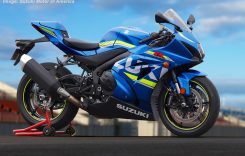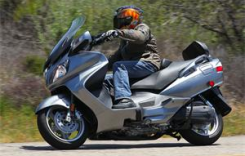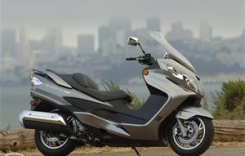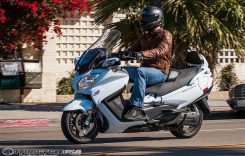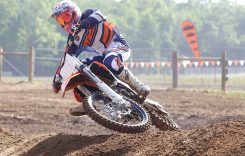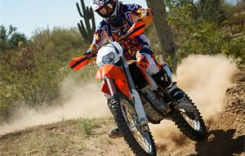KTM went to work with its 450 XC-W for 2012. The “W” line of dirt bikes is designated as trail racing machines. That means they are designed to haul butt in tighter terrain. This year the Austrian team opted for an entirely new engine configuration. The single overhead cam mill gets a new cylinder head, inlet, exhaust port and combustion chamber. It gets a six-speed, wide-ratio transmission and new electric start (with kick start backup). All of this is packed into a new chassis. The XC-W gets the PDS shock system instead of following KTM’s recent switch to linkage design on several models.

We’ll start with the engine because this is definitely the KTM’s strong point. We ran them all across the dyno and the orange bike laid wood to the other three machines with peak horsepower of 46.76. That’s a three-pony advantage over the next closest machine. KTM peaks at 8400 rpm but maximizes torque output (31.78 lb-ft) at 7200 revs. Observing the dyno graphs gives a clear indication of what a rider will feel out on the trail. The XC-W stomps the others with a power spread that is more robust from down low all the way to redline. Several testers noted how quickly the KTM builds rpm. The new Single benefits from electronic fuel injection and has a throttle pull that is impossibly light. Combined they add to a very responsive power delivery.
“The KTM engine definitely stands out amongst the rest of the bikes in the test,” says Garcia. “It has a wider range of power output from bottom to top with the top-end stretching further than those of the competitors. Down low the bike is able to be lugged and tractored through slower sections of trail without stalling.”
But just because the KTM cranks out the most power doesn’t mean it works the best for everyone. Our fastest rider thinks there’s still some room for improvement.
The new engine makes mincemeat of its competition.
“It puts a serious grin on your face when you want to go,” admits Martin. Adding, “It’s smooth in a way, but there is so much of it that it feels abrupt.”
One thing KTM does right is build its bike without compromise for emission standards. With a very palatable 91 decibels from the stock exhaust, the XC-W is nearly the quietest. This is a green-sticker bike just like the rest, but talking with the orange brass makes it clear that they pride themselves on building their bikes to the maximum allowable limit. The Austrians didn’t take any weird shortcuts for meeting regulations like throttle stops and you won’t find any bulbous emission hardware hanging out in plain sight. From our perspective, the XC-W definitely doesn’t feel choked up or detuned. It’s the gnarliest out of the box and lives up to its Ready to Race slogan.
Both of our youngest riders wished for lower gearing, but the Austrian’s six-speed transmission was still a top pick. The wide-ratio tranny finds an occasional false neutral, but no more than the other bikes. On the upside, its hydraulic clutch is absolutely faultless.
“Every clutch should be this easy to pull,” says Dawes. “The feel is consistent no matter how hard you abuse it.”
So the engine and drivetrain are sweet, but we had issues with the handling. Most testers were happy with the suspension performance on bump absorption, but the PDS (no-link) chassis doesn’t feel at home on high-speed desert terrain. KTM uses a chromoly chassis and it feels more flexible than the aluminum frames of the competitors. When picking through the dry waterfall, the KTM’s 261 pounds (lightest by 10 pounds), reactive front end and smooth suspension work wonders. But, when the rocks are loose it feels jittery. It fishtails in sand or on dusty hardpack and won’t settle into turns. The front tire wants to push and then grab suddenly and tuck in. A couple of our testers commented that the suspension only feels like it’s working fully when the engine is at low rpm. Revving the bike loads the shock and causes it to lose traction, especially when accelerating across short, hard rain ruts or stutter bumps.
Technical terrain with embedded rocks is where
the XC-W shines. It dances around unpredictably
in loose conditions.
Justin blankets the topic when he says, “I could never come to grips with the handling of the KTM. The front end pushes like crazy, and the back end wants to slide all over the place. It’s always twitching and moving around. I never felt like I could give it my all on the KTM. I was afraid I’d end up blowing a turn and wind up in a cholla cactus.”
“Stability is questionable in the high-speed, bumpy sections,” adds our Pro racer. “Although the suspension soaks it up well and it is well balanced, I think for how fast the bike is geared to go from the factory, the suspension should be stiffer.”
The power and stopping ability led the KTM to win the braking contest, but it does have a small foot pedal and some testers consider the binding from its dual-piston caliper, 260mm front rotor and single-piston, 220mm rear disc, too abrupt. Martin went as far as to call it a light switch. Overall, it’s impossible to discount the sheer performance available from the brakes.
“As usual the Brembos on the KTM are monsters,” notes the cameraman, Dawes. “Excellent one-finger feel with ridiculous power.”
Getting the 450 XC-W up to speed and hauling it down again is basically as simple as flexing the wrist and fingers on a rider’s right hand. There’s a bit lost in between, however, and some of that comes from the rider interface, which ranked last on our testers’ score sheets.
“I don’t like the cockpit on the KTM,” complains Martin. “It feels cramped and uncomfortable. Although the amazingly comfortable seat helps, I still don’t feel right on the bike. Being a taller rider, the bars are rolled back and too low.”
Pretty much everyone agreed that the bars are a high priority target for aftermarket replacement. It’s a high quality aluminum bar with awesome Renthal hand grips, but the shape of it was unacceptable for even our shortest men. Beefy footpegs are great and the seat is uncharacteristically comfortable for a KTM, but the ergos make it difficult to stand up. Trucking across open desert for a few days really brings out this flaw. Fortunately, there’s still plenty to like about the KTM’s build and individual components.
The XC-W is loaded with top components like wheels and brakes. The Austrians decided to stick with the PDS shock for this model.
Appearances are always subjective, and our testers were split on the Katoom. It ranked second for its sharp outline, high-tech computer (which is a bit difficult to sort out), high ground clearance, quality exhaust, trick wheels and hubs and high-capacity (2.25-gallon) fuel tank. The Yamaha gives it a run with its updated styling, and generally we prefer the Beta’s looks, which matches the KTM blow-for-blow in sweet componentry. They’re basically equals with instrumentation and features. KTM loads its machines with fine details, but so do the Italians, and Beta includes a skid plate.
“KTMs are always sharp-looking machines, but the new look of the WR and the super-fly style of the Beta knock it down,” says JD. “But I wouldn’t kick it out of my garage.”
The desert doesn’t feel like the XC-W’s home environment. This
bike is probably better than it seemed and it still came within
two points of winning the shootout.
One of the most telling discoveries is that none of our testers listed the XC-W as their bike of preference, while every other machine got at least one top vote. The XC-W has plenty to like about it, especially when broken into segments, but as a whole it doesn’t completely win over our test riders. With 128 total points, it falls short of the shootout title by a mere two points. Massive horsepower and torque, light weight and extra fuel capacity let the KTM stack up very well on paper, creaming the competition in the objective scoring despite costing $9199. Out on the desert trail it isn’t nearly as dominant. Our testers couldn’t fault the new SOHC powerplant, but handling woes make this bike one of our least favorite to ride under the given conditions. Any time the terrain gets extremely technical, everyone reaches for the KTM, but the majority of our riding was on looser soil and rock. The KTM struggled to find traction and confidence on both ends of the bike. If this test were conducted elsewhere, the KTM might have been unstoppable. As it stands this time around, it’s a close second.


